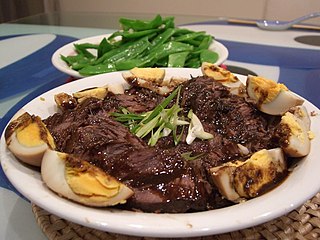
Braising is a combination-cooking method that uses both wet and dry heats: typically, the food is first browned at a high temperature, then simmered in a covered pot in cooking liquid. It is similar to stewing, but braising is done with less liquid and usually used for larger cuts of meat. Braising of meat is often referred to as pot roasting, though some authors make a distinction between the two methods, based on whether additional liquid is added. Osso buco and coq au vin are well known braised meat dishes, and the technique can also be used to prepare fish, tempeh, tofu, or fruits and vegetables.

Linguiça is a Portuguese sausage made from pork and seasoned with onion, garlic, paprika and other spices. It can be used fresh in cooked preparations or undergo a curing and preservation process through smoking.

A schnitzel is a thin slice of meat. The meat is usually thinned by pounding with a meat tenderizer. Most commonly, the meat is breaded before frying. Breaded schnitzel is popular in many countries and is made using veal, pork, chicken, mutton, beef, or turkey. Schnitzel originates in Austria as wiener schnitzel and is very similar to dishes such as escalope in France and Spain, panado in Portugal, tonkatsu in Japan, cotoletta in Italy, kotlet schabowy in Poland, řízek in Czech Republic, milanesa in Latin America, chuleta valluna in Colombia, chicken chop in Malaysia, and chicken-fried steak and pork tenderloin of the United States.
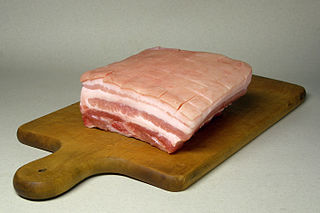
Pork belly or belly pork is a boneless, fatty cut of meat from the belly of a pig. Pork belly is particularly popular in Filipino, Hispanic, Chinese, Danish, Norwegian, Korean, Polish and Thai cuisine.

A lardon, also spelled lardoon, is a small strip or cube of fatty bacon, or pork fat, used in a wide variety of cuisines to flavor savory food and salads. In French cuisine, lardons are also used for larding, by threading them with a needle into meats that are to be braised or roasted. Lardons are not normally smoked, and they are made from pork that has been cured with salt.

Daube is a French slow-cooked stew, usually of beef, but other meat is sometimes used. The best-known is the bœuf en daube à la provençale, a provençal stew made with cheaper cuts of beef braised in wine, with vegetables, garlic and herbs, and traditionally cooked in a daubière – a braising pot.

Mechado is a braised beef dish originating from the Philippines inspired by culinary methods of Spain, of which it was a former colony. Soy sauce and calamansi fruits are key ingredients to the braising liquid.

Carnitas, literally meaning "little meats", is a dish of Mexican cuisine that originated in the state of Michoacán. Carnitas are made by braising or simmering pork in oil or preferably lard until tender. The process takes three to four hours, and the result is very tender and juicy meat, which is then typically served with chopped cilantro, diced onion, salsa, guacamole, tortillas, and refried beans.

Chả lụa or giò lụa is the most common type of sausage in Vietnamese cuisine, made of pork and traditionally wrapped in banana leaves.
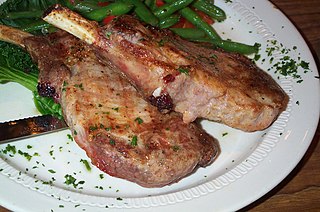
A meat chop is a cut of meat cut perpendicular to the spine, and usually containing a rib or riblet part of a vertebra and served as an individual portion. The most common kinds of meat chops are pork and lamb. A thin boneless chop, or one with only the rib bone, may be called a cutlet, though the difference is not always clear. The term "chop" is not usually used for beef, but a T-bone steak is essentially a loin chop, a rib steak and a rib cutlet.
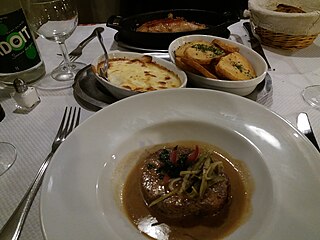
A jambonnette is a form of charcuterie composed of approximately equal parts of chopped pork and bacon enclosed in rind, moulded into a pear shape and cooked. It may also refer to stuffed ham or poultry leg.

Pork is the culinary name for the meat of the pig. It is the most commonly consumed meat worldwide, with evidence of pig husbandry dating back to 5000 BCE.

Lo bah png, also called bah so png in southern Taiwan, or translated to minced pork rice in English, is a rice dish that is commonly seen throughout Taiwan and Southern Fujian. The flavor may vary from one region to another, but the basic ingredients remain the same: ground pork marinated and boiled in soy sauce served on top of steamed rice. It is a type of gaifan dish.

Hamonado, or hamonada, is a Filipino dish consisting of meat marinated and cooked in a sweet pineapple sauce. It is a popular dish during Christmas in Philippine regions where pineapples are commonly grown. Hamonado is also a general term for savory dishes marinated or cooked with pineapple in the Philippines.

Babi kecap is an Indonesian braised pork with sweet soy sauce. It is a Chinese Indonesian classic, due to its simplicity and popularity among Chinese Indonesian households. It is also popular among non-Muslim Indonesians, such as the Balinese, Ambonese, Bataks, Minahasans, and Dayaks, and in the Netherlands among the Indo-Dutch, where it is known as babi ketjap, owing to colonial ties with Indonesia. In the Netherlands, the dish might also be served within an opulent rijsttafel banquet.
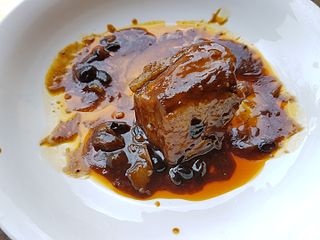
Humbà, also spelled hombà, is a Filipino braised pork dish from Visayas, Philippines. It traditionally uses pork belly slow-cooked until very tender in soy sauce, vinegar, black peppercorns, garlic, bay leaves, and fermented black beans (tausi) sweetened with muscovado sugar. It also commonly includes hard-boiled eggs and banana blossoms.
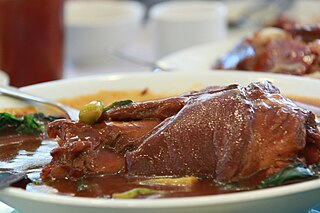
Pata tim, also spelled patatim, is a Filipino braised pork hock dish slow-cooked until very tender in soy sauce, black peppercorns, garlic, bay leaves, and star anise sweetened with muscovado sugar. It also commonly includes péchay and mushrooms. The dish is commonly served in regions in the Philippines with large Chinese Filipino populations, especially in the Binondo district of Manila.
















